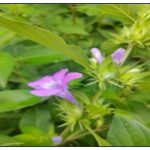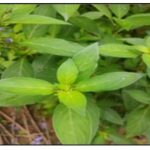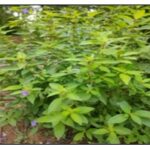A BRIEF REVIEW ON BARLERIA CRISTATA
HTML Full TextA BRIEF REVIEW ON BARLERIA CRISTATA
J. N. Bhoomika * and L. Shiju
Department of Pharmacognosy, Bharathi college of Pharmacy, Bharathinagara, Mandya, Karnataka, India.
ABSTRACT: Barleria cristata, a member of the Acanthaceae family, is a widely distributed perennial shrub indigenous to India. Renowned for its significance in Ayurvedic medicine, this plant is used for its diverse biological and pharmacological properties. The genus Barleria is commonly utilized to treat various ailments such as boils, bee and snake bites, asthma, leprosy, cough, jaundice, and toothaches. Phytochemical screenings of different extracts have identified the presence of alkaloids, carbohydrates, glycosides, phytosterols, flavonoids, phenolic compounds, terpenoids, anthraquinones, and saponins. This review aims to provide a comprehensive scientific overview of Barleria cristata, focusing on its geographical and botanical characteristics and pharmacological activities. The ethnomedicinal applications of this plant include treatments for respiratory diseases like asthma, cough, bronchitis, and tuberculosis. Additionally, Barleria cristata has been noted for its ornamental value due to its vibrant flowers. It also plays a role in soil stabilization and erosion control. Pharmacological studies have demonstrated Barleria cristata's anti-inflammatory, antibacterial, antidiabetic, antimicrobial, antioxidant, wound-healing, and hepatoprotective properties.
Keywords: Barleria cristata, Acanthaceae, Anti-inflammatory, Antibacterial, Hepatoprotective
For thousands of years, people have turned to plants for their healing properties. Even before recorded history, ancient civilizations incorporated herbs into their healing practices. Evidence from ancient manuscripts, Egyptian papyri, and Chinese texts shows how herbs like those from Glycyrrhiza glabra, Cedruslibani, Cupressus arizonica, Papaver somniferum and Commiphora acuminate were used to treat ailments like colds, coughs, swelling, and parasitic diseases. India, in particular, has been known for its rich tradition of medicinal plants.
The country's forests are a treasure trove of both medicinal and aromatic plants, which are collected for making medicines and perfumes. There are around 8,000 herbal remedies documented in India’s AYUSH systems, which include Ayurveda, Unani, Siddha, Homeopathy, and Tribal (Folk) medicines. Since the time of the Rig Veda, around 5600 BC, medicinal plants have played a crucial role in treating various illnesses in India. Out of approximately 250,000 higher plant species, over 80,000 have medicinal properties. Tribal communities have developed detailed herbal knowledge based on generations of experience and observation 1.
Barleria cristata is a widely cultivated ornamental plant that has recently spread to South China, Southeast Asia, and the subtropical and tropical regions of India. It is also recognized as a potential environmental weed in disturbed areas, such as roadsides and waste places. Across India, B. cristata is commonly used as hedges around fields and gardens. Traditional medicine in India has utilized this plant to treat a variety of conditions, including toothache, anemia, snake bites, diabetes, lung disorders, blood diseases, and inflammation. Phytochemical studies have identified B. cristata as being rich in triterpenes, flavonoids, phenolic compounds, iridoidal glycosides, and phenylethanoid glycosides.
Recent pharmacological research has further demonstrated its diverse biological activities, such as anti-inflammatory, antibacterial, antidiabetic, antioxidant, antifungal, hepatoprotective, and antiplasmodial effects. This review highlights B. cristata as a promising source of bioactive compounds, providing a comprehensive overview of its medicinal uses and related phytopharmacological studies. Additionally, it critically evaluates pharmacological research in light of its traditional uses. To the best of our knowledge, this is the first detailed review of B. cristata’s therapeutic potential, offering valuable information that could inform future research, especially in the context of clinical trials 2.
Barleria is a genus of plants that can be easily identified by a few distinct characteristics. it has a calyx with two large outer segments and two smaller inner ones, pollen that looks like tiny honeycombs, and epidermal cells with unique double cystoliths. The most well-known species in this genus is Barleria cristata L., commonly called the Philippine violet, which belongs to the subgenus Barleria. Within this subgenus, there are seven distinct groups, or clades, including the Cristata clade, which itself is divided into three smaller groups: the Acanthoideae clade, the core Cristata clade, and the Rigida clade. The core Cristata clade includes B. cristata along with two closely related species, B. aculeata (found only in Socotra) and B. nitida (native to India and Sri Lanka). Barleria cristata originates from South Asia and is widespread across India. It’s often grown for its striking flowers, though it can also grow wild. Because it’s popular in gardening, many different varieties are available, especially those with different flower colors like white, pink, striped, and blue. The plant adapts well to different environments across India, which leads to variations in its appearance. In addition to its beauty, B. cristata is valued in traditional medicine, particularly for treating lung issues and inflammation. So far, researchers have identified 22 different compounds in this species, mainly flavones, flavonoids, phenolics, and phenolic glycosides. Given its importance both as an ornamental and a medicinal plant, it’s crucial to understand the variations within B. cristata and define its specific characteristics 3.
Botanical Description: Barleria cristata L. is a large, upright shrub without thorns that grows well in fertile, well-drained soil with plenty of sunlight or partial shade. The stems are covered with fine hairs, especially where the leaves attach. The leaves, measuring 2.5 to 10 cm in length, are narrow, pointed, and have slightly hairy edges. The upper side of the leaves is dark green, while the underside is usually lighter in color, and they are attached by short stems. The plant produces soft whitish-pink flowers that are about 2 cm long, shaped like a funnel, and grow in dense clusters at the ends of the branches or where the leaves meet the stem. The outer green part of the flower is 2 cm long, shaped like a lance, and has finely toothed edges. The petals form a tube that is 6-7 cm long, with a violet or nearly white upper part and pink glandular hairs on the outside. Inside the flower, there are four stamens (the male parts) that are about 2.5 cm long, with 3 mm long hairy anthers, and some shorter, non-functional stamens. The nectar is stored in a two-lipped structure around the lower half of the ovary (the part that develops into fruit). The ovary contains two ovules, and the style (which connects the ovary to the stigma) is cylindrical and hairy at the base. The stigma has two pink lobes that are slightly enlarged. The seeds are flat and oval, featuring a covering of silky, soft hairs. The plant usually flowers and produces fruit from September to February in the Indian subcontinent 2.
Taxonomy of Barleria cristata 4:
Kingdom: Plantae
Sub-kingdom: Tracheobionta
Division: Mangnoliophyta
Class: Magnoliopsida
Sub-class: Asteridae
Order: Scrophulariales
Family: Acanthaceae
Genus: Barleria
Species: Cristata
Synonyms: Barleria alba, Barleria indica and Barleria napalensis.
FIG. 1: BARLERIA CRISTATA FLOWER
FIG. 2: BARLERIA CRISTATA LEAF
FIG. 3: BARLERIA CRISTATA PLANT
Pharmacological Activity:
Anti-inflammatory Activity: The anti-inflammatory potential of the Barleria cristata aqueous extract of leaves was determined using multiple experimental models. The anti-inflammatory effects of BCW at doses of 125, 250, and 500 mg/kg were tested in acute inflammatory models, including carrageenan-induced paw edema in rats, prostaglandin inhibition, and acetic acid-induced capillary permeability in mice. Results were analyzed with one-way ANOVA followed by Dunnett's test, with P < 0.05 considered significant compared to the control group. This extract significantly inhibited carrageenan-induced edema, prostaglandin activity, and vascular permeability in a dose-dependent manner. Indomethacin (10 mg/kg) served as the positive control. The study reveals that the aqueous extract from Barleria cristata Linn leaves possesses strong anti-inflammatory properties 5, 6, 7.
Antibacterial Activity: The antibacterial properties of methanol and aqueous extracts from Barleria cristata leaves were assessed against the Gram-positive bacterium Streptococcus pyogenes and the Gram-negative bacterium Escherichia coli NCTC 10418 using the well diffusion method. The methanolic extract exhibited substantial antibacterial activity, with inhibition zones of 77.06% against E. coli and 78.5% against Streptococcus pyogenes. The aqueous extract showed moderate activity, with inhibition zones of 64.2% for E. coli and 68.8% for Streptococcus pyogenes. The methanolic extract's superior efficacy suggests it contains more potent antibacterial compounds. These results underscore the potential of Barleria cristata leaf extracts in developing treatments for wounds and skin infections, offering a promising alternative to conventional antibiotics 8, 9, 10.
Antifungal Activity: As fungal infections continue to spread and current treatments fall behind, the pressing need for breakthrough therapeutic options is more evident than ever. Barleria cristata, a shrub from the Acanthaceae family native to Central and South India, has gained attention for its potential antifungal properties. Traditionally used in various medicinal applications, this plant's antifungal activity is now being actively explored. Research into B. cristata has identified bioactive compounds in its leaf extracts, including flavonoids, alkaloids, and phenolic compounds, known for their antimicrobial effects. Recent studies have focused on evaluating the antifungal efficacy of ethanolic leaf extracts against a range of fungal pathogens. Preliminary results indicate that these extracts possess significant antifungal activity, suggesting that B. cristata could be a valuable source of new antifungal agents. Further research is necessary to elucidate the specific mechanisms by which B. cristata extracts exert their antifungal effects. Potential mechanisms may include the disruption of fungal cell membranes or inhibition of critical fungal enzymes. The promising findings from current studies underscore the potential of Barleria cristata in developing novel treatments for fungal infections 11, 12.
Hepatoprotective Activity: The hepatoprotective potential of the ethanolic leaves extract of Barleria cristata has been investigated using a carbon tetrachloride (CCl₄) induced liver damage model in male Wistar albino rats. The study administered the extract at 100 and 200 mg/kg body weight, showing notable hepatoprotective effects. Biochemical analysis showed that the extract significantly (P<0.001) reduced serum levels of hepatospecific enzymes, including serum glutamic pyruvic transaminase (SGPT), serum glutamic oxaloacetic transaminase (SGOT), and alkaline phosphatase (ALP). It also significantly lowered total bilirubin levels, total protein levels, cholesterol, and triglycerides levels. Silymarin, a standard hepatoprotective drug used for comparison at a dose of 25 mg/kg, exhibited significant hepatoprotective activity (P<0.001). Additionally, the ethanolic extract did not show any mortality up to a dose of 2000 mg/kg body weight, indicating a favorable safety profile. Histopathological examination confirmed the biochemical findings, showing marked improvement in liver histology in the extract-treated groups compared to the CCl₄ control group. These results indicate that the ethanolic extract of Barleria cristata possesses significant hepatoprotective properties, likely due to the presence of bioactive compounds such as alkaloids and flavonoids. Consequently, Barleria cristata could be a promising candidate for developing natural hepatoprotective drugs. Further investigations should focus on isolating and characterizing the active constituents, under-standing the molecular mechanisms underlying the hepatoprotective action, and evaluating the efficacy and safety of the extract in human subjects. In conclusion, Barleria cristata represents a valuable natural resource with potential therapeutic benefits for liver protection, warranting further research and development 13, 14.
Antidiabetic Activity: Plant-based anti-diabetic drugs are increasingly favored due to their reduced side effects and lower cost compared to conventional treatments. Conventional diabetes medications work by enhancing insulin sensitivity, increasing insulin production, or lowering blood glucose levels. However, these drugs may have adverse effects and may not always effectively manage blood glucose levels or prevent complications. Plants have long been used in medicine, and many possess therapeutic potential. Given the global prevalence of diabetes, it is essential to explore and validate the anti-diabetic properties of plants like Barleria cristata L. (Acanthaceae). The hypoglycemic activity of alcoholic extracts from dried Barleria cristata seeds was tested in Wistar rats (150-200 g). Blood glucose levels were measured using a digital glucometer, and oral administration of the seed extracts at 200 mg/kg resulted in a significant reduction in blood glucose. This finding underscores the need for further research into the active compounds responsible for these hypoglycemic effects 15, 16.
Antioxidant Activity: In India, this plant has been traditionally valued for its medicinal properties. This study involved a preliminary phytochemical screening, quantitative analysis of secondary metabolites, vitamin content assessment, and an evaluation of in-vitro antioxidant activity. The screening revealed the presence of key phytochemicals, including alkaloids, flavonoids, glycosides, saponins, phenols, and tannins, in both ethanol and aqueous extracts. Notably, the 50% ethanolic leaf extract exhibited significant antioxidant activity, likely due to the abundance of secondary metabolites, suggesting its potential as a future antioxidant agent 17, 18.
CONCLUSION: This review highlights the substantial potential of Barleria cristata as a potent medicinal plant. As we've explored its botanical description and taxonomy, it’s clear that this plant is more than just a part of traditional remedies; it’s a treasure trove of health benefits waiting to be fully unlocked. The anti-inflammatory properties of Barleria cristata make it a natural choice for managing conditions like arthritis and other chronic inflammatory issues. Its antibacterial and antifungal abilities are particularly exciting, especially in a time when antibiotic resistance is a growing concern. Plus, the fact that it has hepatoprotective effects meaning it can help protect the liver adds even more value, potentially offering new ways to support liver health. The review also highlights how Barleria cristata could play a role in managing diabetes, a condition that affects millions worldwide. Its antioxidant activity is another major plus, helping to fight off oxidative stress and potentially preventing various chronic diseases. As we continue to learn more about Barleria cristata, there’s real hope that it could lead to the development of new, natural treatments that are both effective and gentle on the body. This plant’s diverse pharmacological profile not only validates its traditional uses but also points to a bright future where it could be central to new health innovations. The story of Barleria cristata is just the beginning, and it’s one worth following closely.
ACKNOWLEDGEMENT: Nil
CONFLICT OF INTEREST: Nil
REFERENCES:
- Kumudhaveni B, Radha R, Jiyavutheen M, Kavithasai M and Kowsalya J: A Review on phytochemical and pharmacological activity of medicinal plant Barleria cristata. Research Journal of Pharmacy and Technology 2020; 13(2): 999-1003.
- Kumar H, Agrawal R and Kumar V: Barleria cristata: perspective towards phytopharmacological aspects. J of Pharmacy and Pharmacology 2018; 70(4): 475-87.
- Tamboli AS, Patil SS, Kadam SK, Choo YS, Lekhak MM and Pak JH: Morphology, palynology and molecular phylogeny of Barleria cristata (Acanthaceae) morphotypes from India. Diversity 2022; 14(8): 677.
- Gangaram S, Naidoo Y, Dewir YH and El-Hendawy S: Phytochemicals and biological activities of Barleria (Acanthaceae). Plants 2021; 11(1): 82.
- Gambhire MN, Wankhede SS and Juvekar AR: Antiinflammatory activity of aqueous extract of Barleria cristata Journal of Young Pharmacists 2009; 1(3): 220.
- Gambhire Manoj N, Wankhede Shaijesh S and Juvekar Archana R: Anti-inflammatory activity of fractions of the Barleria cristata leaves extract.
- Kaur PK, Vasisht K and Karan M: Anti-inflammatory studies in relation to chemical evaluation on two species of an indigenous drug ‘Barleria’. Int J Pharm Pharm Sci 2014; 6(11): 377-83.
- Sulthana BS, Honey E, Anasuya B, Gangarayudu H, Reddy MJ and Girish C: Investigation of anti-bacterial activity of different extracts of Barleria cristata Int J Health Sci 2017; 7: 90-5.
- Salib JY, Nabila HS, Helana NM and Emad FE: Antibacterial activity of Barleria cristata bark extracts. Journal of Applied Sciences Research 2013; 9(3): 2156-9.
- Myint S, Moe ZM and Khaing MM: Morphological characters of Barleria cristata and Barleria prionitis L. and their antimicrobial activities. J Myanmar Acad Arts Sci 2020; 18: 183-91.
- Darling Chellathai DC, Punnagai Gunasekaran PG and Aparna Mani AM: Evaluation of antibacterial and antifungal activity of Barleria cristata an in-vitro
- Chellathai D, Gunasekaran P and Mani A: Evaluation of antibacterial and antifungal activity of Barleria cristata an in vitro study. World J Pharm Res 2015; 2: 1253-8.
- Balaji P, Kishore G and Verma Y: In-vivo hepatoprotective activity of Barleria cristata ethanolic leaf extracts against ccl^ sub 4^ induced hepatic injury in Wistar rats. Pharmacie Globale 2013; 4(4): 1.
- Verma R: A review on hepatoprotective activity of medicinal plants. J Med Plants Stud 2018; 6(1): 188-90.
- Singh R, Rajasree PH and Sankar C: Screening for anti-diabetic activity of the ethanolic extract of Barleria cristata Int J of Pharmacy & Life Scien 2012; 3(10).
- Dheer R and Bhatnagar P: A study of the antidiabetic activity of Barleria prionitis Indian Journal of Pharmacology 2010; 42(2): 70-3.
- Amutha K and Doss D: In-vitro antioxidant activity of ethanolic extract of Barleria cristata Leaves. Research J of Pharmacognosy and Phytochemi 2009; 1(3): 209-12.
- Schlesier K, Harwat M, Böhm V and Bitsch R: Assessment of antioxidant activity by using different in-vitro Free Radical Research 2002; 36(2): 177-87.
How to cite this article:
Bhoomika JN and Shiju L: A brief review on Barleria cristata. Int J Pharmacognosy 2024; 11(9): 452-56. doi link: http://dx.doi.org/10.13040/IJPSR.0975-8232.IJP.11(9).452-56.
This Journal licensed under a Creative Commons Attribution-Non-commercial-Share Alike 3.0 Unported License.
Article Information
2
452-456
673 KB
709
English
IJP
J. N. Bhoomika * and L. Shiju
Department of Pharmacognosy, Bharathi college of Pharmacy, Bharathinagara, Mandya, Karnataka, India.
bhoomikajn30@gmail.com
14 August 2024
17 September 2024
27 September 2024
10.13040/IJPSR.0975-8232.IJP.11(9).452-56
30 September 2024






